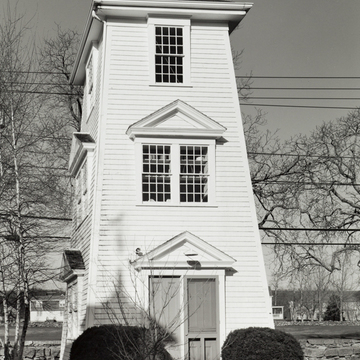The shingled Church House is the most interesting in Adamsville. Of extraordinary scale for the early nineteenth century, it is virtually a square with paired interior chimneys. More extraordinary are two identical five-bay entrance elevations on its north and east sides, with duplicate fanlighted entrances at the center of each. The north front, toward Adamsville Road, is now the principal entrance. At right angles to this, the east front, originally intended as the principal entrance with flanking
Dr. Hathaway built a water tower at the rear of the property on Westport Harbor Road when he owned the house in the early twentieth century. It once housed a pump on the first floor and chauffeur's quarters above, with the tank on top. It is a beautifully proportioned example of Neo-Colonial design applied to an eccentric building, which again seems to invoke Little Compton's onetime windmills.








